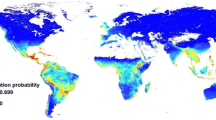Abstract
Invasion by exotic species is a prime threat to biodiversity and information on their expanse is pivotal for effective management of bioresources, with this perception we worked out the extent of occurrence (EOO) and area of occupancy (AOO) of Sapium sebiferum (L.) Roxb. in the Himalayan state of Himachal Pradesh (HP), as is done for IUCN plant threat categorization. Three methods namely aerographic method (AM), cartographic method (CM) and cartographic method by conglomerates (CMC) were deployed and compared for the same in the geographic information system environment. As expected, the three results varied amongst themselves, with AOO being 1127.58, 4046.00 and 734.12 sq km for AM, CM and CMC, respectively. On the other hand the EOO was 4,091.44 sq km. This is a considerable expanse and amounts to more than 7 % of the total geographical area of HP. Based on field surveys and observations, CMC was found to give the most reliable estimates. Though, primarily devised by IUCN for threat categorization of native species, we feel that EOO and AOO may appropriately be applied to invasive species also.





Similar content being viewed by others
References
Drake JA, di Castri F, Grooves RH, Druger FJ, Mooney HA, Rejmanek M, Williamson M (1989) Biological invasion: a global perspective—SCOPE 37. Wiley, Chichester
Randall JM (1996) Weed control and the preservation of biological diversity. Weed Technol 10(2):370–383
Wilcove DS, Rothstein D, Dubow J, Philips A, Losos E (1998) Quantifying threats to imperiled species in the United States. Bioscience 48:607–615
Cameron GN, Spencer SR (1989) Rapid leaf decay and nutrient release in a Chinese tallow forest. Oecologia 80:222–228
Putz FE, Holdnak M, Niederhofer M (1999) Controlling invasive exotics: a tallow tree replacement programme campaign in Florida. J Agric 25(2):98–101
Bruce KA, Cameron GN, Harcombe PA (1995) Initiation of a new woodland type on the Texas coastal prairie by the Chinese tallow tree (Sapium sebiferum (L.) Roxb.). Bull Torrey Bot Club 122:215–225
Grace JB (1998) Can prescribed fire save the endangered coastal prairie ecosystem from Chinese tallow invasion? Endanger Species Update 15:70–76
Barrilleaux TC, Grace JB (2000) Growth and invasive potential of Sapium sebiferum (Euphorbiaceae) within the coastal Prairie region: the effects of soil moisture regime. Am J Bot 87(8):1099–1106
Pattison RR, Mack RN (2008) Potential distribution of the invasive tree Triadica sebifera (Euphorbiaceae) in the United States: evaluating CLIMEX predictions with field trials. Glob Chang Biol 14:813–826
Jaryan V, Chopra S, Uniyal, Sanjay Kr, Singh RD (2007) Spreading fast yet unnoticed: Are we in for another invasion? Curr Sci 93(11):483–484
IUCN (2001) IUCN red list categories and criteria: version 3.1. IUCN Species Survival Commission, UK
Barnett DT, Stohlgren TJ, Jarnevich CS, Chong GW, Ericson JA, Davern TR, Simonson SE (2007) The art and science of weed mapping. Environ Monit Assess 132:235–252
Foxcroft LC, Richardson DM, Rouget M, MacFadyen S (2009) Patterns of alien plant distribution at multiple spatial scales in a large national park: implications for ecology, management and monitoring. Divers Distrib 15:367–378
Balokhra JM (2002) The wonderland of Himachal Pradesh. HG Publication, New Delhi
Chandrasekhar MB, Singh S, Roy PS (2003) Geospatial modeling techniques for rapid assessment of phytodiversity at landscape level in western Himalayas, Himachal Pradesh. Curr Sci 84:663–670
Chowdhery HJ, Wadhwa BM (1984) Flora of Himachal Pradesh, vol 1, 2 and 3. BSI, Calcutta
Chowdhery HJ (1999) Himachal Pradesh. In: Mudgal V, Hajra PK (eds). Floristic diversity and conservation strategies in India, vol II. BSI, Calcutta, pp 845–887
Bhagat RM, Singh S, Kumar V (2006) Agro-ecological zonation of Himachal Pradesh-agricultural system information development at micro-level. CSK Himachal Pradesh Agriculture University, Palampur
Singh K, Kapur SK, Sarin YK (1993) Domestication of Sapium sebiferum under Jammu conditions. Indian For 119(1):36–42
Sharma S, Rikhari HC, Palni LMS (1996) Adoption of a potential plantation tree crop as an agroforestry species but for the wrong reasons: a case study of the Chinese tallow tree from central Himalaya. Int Tree Crop J 9:37–45
ESRI (2002) ArcGIS 8.3 user manuals. Redlands, USA
Hernandez HM, Navarro M (2007) A new method to estimate areas of occupancy using herbarium data. Biodivers Conserv 16:2457–2470
Willis F, Moat J, Paton A (2003) Defining a role for herbarium data in red list assessment: a case study of Plectranthus from eastern and southern tropical Africa. Biodivers Conserv 12:1537–1552
Golding JS (2004) The use of specimen information influences the outcomes of red list assessments: the case of southern African plant specimens. Biodivers Conserv 13:773–780
Kunin WE (1998) Extrapolating species abundance across spatial scales. Science 281:1513–1515
Hartley E, Kunin WE (2003) Scale dependency of rarity, extinction risk, and conservation priority. Conserv Biol 17:1559–1570
Jubinsky G (1993) Chinese tallow gets worse! Palmetto 13(3):3
Renne IN, Wylie C, Barrow JR, Lori A, Randall J, William C, Bridges JR (2002) Generalized avian dispersal syndrome contributes to Chinese tallow tree (Sapium sebiferum, Euphorbiaceae) invasiveness. Divers Distrib 8:285–295
Bruce KA, Cameron GN, Harcombe PA, Jubinsky G (1997) Introduction, impact on native habitats, and management of a woody invader, the Chinese tallow tree Sapium sebiferum (L.) Roxb. Nat Areas J 17:255–260
Acknowledgments
The authors are thankful to the Director IHBT for support and encouragement. Staff and faculty members of IHBT herbarium are thanked for fruitful discussions and valuable suggestions. Thanks are due to the Council of Scientific & Industrial Research for providing the necessary facilities. The anonymous reviewer(s) are acknowledged for their constructive comments.
Author information
Authors and Affiliations
Corresponding author
Rights and permissions
About this article
Cite this article
Jaryan, V., Uniyal, S.K., Kumar, A. et al. Extent of Occurrence and Area of Occupancy of Tallow Tree (Sapium sebiferum): Using the Red list Criteria for Documenting Invasive Species Expanse. Natl. Acad. Sci. Lett. 36, 85–91 (2013). https://doi.org/10.1007/s40009-012-0103-1
Received:
Revised:
Accepted:
Published:
Issue Date:
DOI: https://doi.org/10.1007/s40009-012-0103-1




